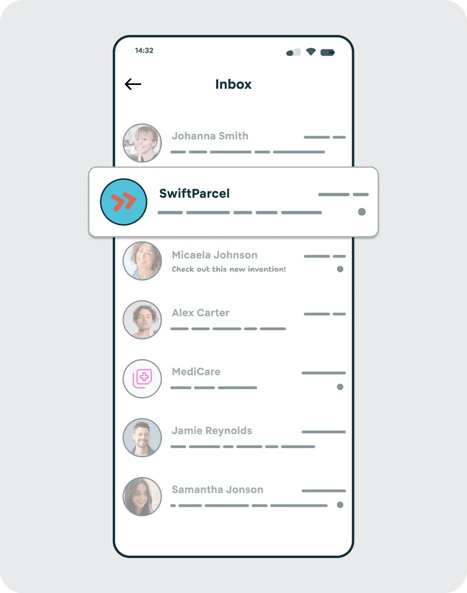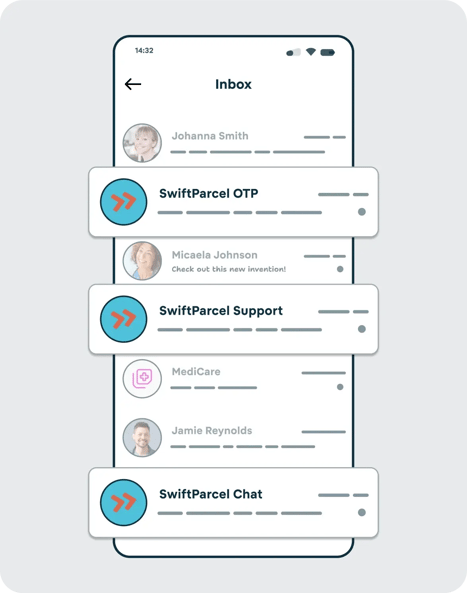RBM agent use cases explained
RCS is more than a channel; it’s a framework for branded, verified and interactive conversations. Registering the right use case is more than a checkbox – it defines what you’re allowed to send, how you handle customer experience, and how easily your messages get approved. Use cases fall into four categories:
1. OTP (one-time password)
Messages that help users verify identity, log in, or complete sensitive actions must be fast, focused, and never mixed with other content.
2. Transactional
Used for order confirmations, delivery updates, booking reminders, account changes or critical alerts. Think “utility-first” and avoid any promotional language.
3. Promotional
Great for marketing messages, limited-time offers, product launches, and engagement campaigns. Promotional agents can initiate conversations with users (with opt-in), which is especially valuable for re-engagement and marketing automation.
4. Multi-use
A blend of transactional and promotional content, where a journey starts with utility and transitions into value. Think: flight check-in followed by an upgrade offer. Multi-use also enables conversational RBM, letting customers interact with your brand in one thread for multiple intents
| Use case |
Purpose |
Example message |
Can start conversation? |
Includes replies? |
| OTP |
Authenticate users with codes |
"Your login code is 728491. It expires in 10 mins." |
❌ |
❌ |
| Transactional |
Notify users about service events |
"Your order #5678 has shipped. Track it here." |
❌ |
✅ |
| Promotional |
Drive engagement and sales |
"20% off ends tonight! Tap to shop the collection." |
✅ |
✅ |
| Multi-use |
Combine utility and value, enable conversations |
"Your invoice is ready. Want to pay in instalments?" |
✅ |
✅ |
One agent = one experience. Choose wisely.
Each RCS agent is a dedicated identity for a specific message type or experience. Think of it as a branded sender profile. Choosing the right one affects what messages you’re allowed to send.
Single or multiple agents: what works best?
There’s no universal answer; it depends on your use cases, internal structure, and how you want to grow. Here’s a breakdown to guide your setup.
Single-agent setup

Use when:
• You’re launching with one clear purpose (e.g. notifications or support)
• Branding is consistent across all touchpoints
• You’re a startup or smaller business looking to scale gradually
• You want users to experience a unified thread for all communication
Benefits:
• Easier management
• Unified message thread reduces end-user confusion
• Faster time to market
• Streamlined approval and message tracking
Limitations:
• Can’t mix certain content types (e.g. promos on an OTP agent)
• Might complicate flows as use cases expand
• You must qualify for multi-use approval to send multiple content types in one thread
Multi-agent setup

Use when:
• You run separate teams or functions (e.g. marketing, support, operations)
• You want to keep compliance and reporting clean
• You’re launching multiple campaigns in parallel or operate globally
Benefits:
• Clear separation of conversations types
• More scalable over time
Limitations:
• Customers will see multiple message threads from your brand
• Brand experience can feel fragmented if not tightly coordinated
Pro tip: Avoid using a promotional agent for critical updates – those messages may be blocked if not aligned with the use case.
Agent registration: best practices
Agent registration isn’t just an administrative step, it sets the tone for your entire RBM programme. Here’s what to get right:
-
Choose the correct use case. Each agent can only serve one type. Multi-use is an exception but still needs to follow structure.
-
Show how users opt in. Especially important for promotional and multi-use flows.
-
Stay on-brand. Ensure logos, descriptions, and message tone reflect your business identity.
-
Be region-aware. Some countries have restrictions (e.g. promotional agents may have message caps or time limits).
Real-world setup: how a modern brand might structure rbm agents
Let’s say you’re a Nordic logistics company:
| Agent name |
Use case |
Message examples |
| SwiftParcel OTP |
OTP |
Login codes, verification for deliveries |
| SwiftParcel Support |
Transactional |
Shipment status, reschedule confirmations |
| SwiftParcel |
Promotional |
Campaigns, loyalty programme, discount offers |
| SwiftParcel Chat |
Multi-use |
Track & trace + offer on express delivery |
Checklist for a scalable agent setup
✅ Start with one agent if needed, but plan with flexibility in mind
✅ Always match message intent with agent type
✅ Separate OTP from everything else
✅ Use multi-use only when both message types are logically connected
✅ Keep branding and tone consistent across agents
Register a RCS Business Messaging agent
The most successful brands using RBM start with a solid foundation. By understanding the use cases, structuring your agents around them, and keeping the customer journey at the centre, you’ll not only reduce friction but also unlock richer engagement, higher delivery rates, and better campaign performance.
Launching RCS should feel exciting, not overwhelming. Whether you’re registering your first agent or refining your entire RCS strategy, our team’s here to help. Book a free RCS consultation or learn how your existing SMS API can unlock branded and verified RCS messages.

❗Important notice
The agent structure and use case recommendations outlined in this article are designed to guide strategic planning – not to serve as formal instructions for production approval. Actual requirements for agent registration, message types, and use case eligibility can vary by region and are subject to change. Before launching, always confirm the latest policies with your RCS provider (such as LEKAB) or consult Google's official documentation to ensure compliance with local and carrier-specific rules.


